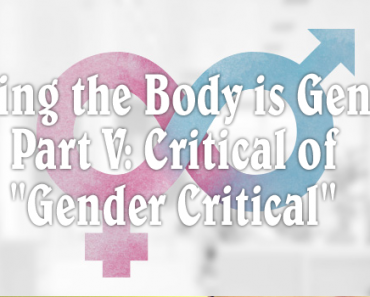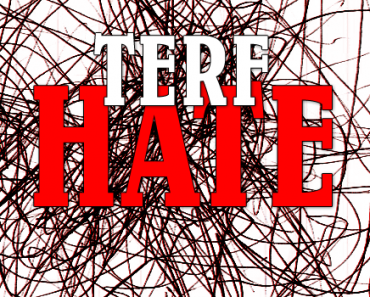By Lisa Kalayji
Do you remember the 1990s MTV cartoon Daria? If you’re old enough and young enough, you probably do. For those who missed it or are enjoying the memory slippages which apparently start at a lot earlier age than our parents told us they would, Daria was a cartoon series about a highly intelligent, cynical, and socially outcast teenaged girl, and she has something to teach us about the logic which gives rise to trans-exclusive radical feminism.
In the third episode of season two, Daria’s vapid, vain, and socially worshipped younger sister, Quinn, writes a marginally decent essay for a class, which is then enthusiastically shared with her class by her teacher, much to Quinn’s mortification. Rather than the expected social backlash of being academically adept, however, Quinn experiences a surge in her popularity, and her apparent wits are coveted rather than maligned and ridiculed.
This new adoration for Quinn’s (comparatively undeserved) academic abilities leaves Daria feeling surprisingly dejected. After being socially isolated, resented, and ridiculed for her intellectual prowess for years, Daria feels robbed. Her identity as ‘a brain’, while it’s cost her a great deal in social life, has become incredibly dear to her. To have that identity, troublesome though it often is, taken from her and exalted in Quinn after Daria’s own long-suffering for it, leaves her feeling deprived of the hard-achieved social niche that her fortitude in the face of social pressures has earned her.
Daria’s unexpected turmoil contains a crucial insight about the TERF stance toward transpeople, and particularly toward transwomen (who, as many of you know, are TERFs’ public enemy #1). Feminism is a social movement about, by, and for women. Women’s oppression and exploitation at the hands of men is a tale as old as time – pretty much literally – and the fight against it has had unimaginably high costs for untold thousands of women who have, through small acts of resistance in daily interpersonal life, international-scale women’s liberation projects, and everything in between, walked the path of most resistance to assert their right, and the rights of their sisters-in-arms, to respect, dignity, autonomy, and full socio-political participation as women.
As this long-wearing battle for the most basic human entitlements – freedom from physical and sexual assault, safety from attack and harassment on the streets, recognition of physical and intellectual ability, bodily autonomy, self-determination, and high social valuation – has worn on and on through generations of relentless misogyny, women’s identity has taken on a very special meaning for feminists. Womanhood is, to feminists, more than just an accident of birth, more than the exclamation ‘it’s a girl!’ that a doctor or midwife announces in a delivery room, and even more than the sum of the many burdens and oppressions and micro-aggressions raining down on women almost every moment of every day of our lives. Womanhood is an identity that we fight hard for simply by existing as women, because no one gives us a choice – merely being a woman is a fight, whether or not you call yourself a feminist and whether or not you see other women as the comrades that they are.
Imagine the horror and indignation of some women, then, when transsexual people became recognized and sex transition treatments began being offered to transpeople. After years and decades and centuries and millennia of being subjugated by every human creature with a penis (and yes, sadly, even feminist-minded men are part of the infrastructure of sexism, even if they don’t want to be), women were informed that some of those human creatures with penises identify as women, and now have a way to bring their bodies into alignment with their experienced identities as women.
To the average woman on the street, what makes the concept of transwomen most threatening is probably the queerphobia that has saturated the world for years and is only recently beginning to be dismantled. For entrenched and long-suffering feminists, though, a transwoman is something different than just a queer who’s out to recruit their kids to the gay agenda. After years of crawling on our elbows through the feminist trenches, under heavy fire from men everywhere (including most of those who claimed to be on the side of feminists), giving tremendous time and energy to a fight that shouldn’t need fighting (still, still fighting this fight? still?!), feminists were now being asked to accept people assigned male at birth – people who’ve been enjoying the social privileges of being, by default, on the winning side of the gender battlefield and contributing, deliberately or not, to the oppression that women are literally dying to defeat – as women?
This is how you get a TERF. Like Daria, feminists have paid a tremendous price for our unwillingness to cave to social pressures to conform and to quietly cooperate with our own subjugation. Dangerous though it is to be a feminist in a misogynistic world, feminists do it, resisting, confronting, and outright battling the patriarchy in various spheres of public and private life. Our identity as women is precious to us, because we are daily punished for it, and we have to fight uphill battles every day that men can never really understand, even if they think they do. This social position as women may cost us a lot, but we love that identity in a way that only we can, precisely because every woman, by choice or by compulsion, is a warrior in the battlefield of patriarchy. When the Quinn of transwomen comes to take on that identity, TERFs don’t just see the spectrum of gender identities getting more diverse, or new paths to sex and gender liberation opening up. A TERF sees the enemy walking into the women’s camp and claiming to have been there all along.
The trouble is, that’s not what’s happening. A transwoman’s claim to have been, in her true sense, a woman all her life is not a claim to have been subjected to the exact same experiences that a person assigned female at birth has experienced. The recognition of the legitimacy of transwomen is not a loss on the part of feminists. Feminism is a politics of liberation – of eliminating restrictions on the way bodies are positioned in the social world, where they can be located, what they can look like, what they can do, and what their owners – the only people who should have any say in the matter – get to do with and to them. As many before me have said and many after me will say, the diversification and multiplicity of gender identities and expressions is a valuable addition to the feminist project, and feminists and transpeople belong shoulder-to-shoulder in the fight for broad-based sex and gender liberation.
Daria’s predicament resolved when she retaliated by co-opting Quinn’s identity of vanity and popularity, causing Quinn to react as defensively as Daria had, and promptly abandoning her pretenses to ‘brain’ identity. That is where the parallel between Daria and Quinn and TERFs and transwomen ends. Outgoing and appearance-focused women can be intellectuals, too. ‘Brainy’ women can be socially popular. Neither Daria nor Quinn needed to lose anything, any part of their identity, for that identity to be shared by the other. Their resolution was the wrong resolution. So is the TERF approach to transwomen. Women don’t lose anything by counting transwomen as women, or as feminists, or both. Transwomen are women, and a truly liberated world for women simply doesn’t have room for restrictions on how women, trans or otherwise, can identify or live in their own bodies. All women are warriors, and we can do better than that.



… I’d be much happier about this article if it explained, for the benefit of the TERF crowd, WHY it isn’t true that trans women are enjoying male privilege and then “invading” female spaces.
Analogy is great, but I can’t show it to anyone who wouldn’t already agree with it. =/
Because trans women aren’t men?
I mean, if you believe that trans women posses an immutable male-essence of some sort, maybe you should think about the foundational assumptions one must accept prior to making such an assertion? Here’s a post on essentialism that you might want to read.
Funnily enough, I always sort of read Quinn as being secretly a trans girl.
So THAT’S why Sandi got so angry and jealous when people saw Quinn as the best in her group.
God this is so true. The #TERF claiming “Transwomen erase lesbians” that is at the core of their fantasy screams a jealousy of anyone but them getting attention. The #TERF sock puppet army is bizarre attempt at trying to secure women’s rights by taking away other peoples. It is illogical and shallow.